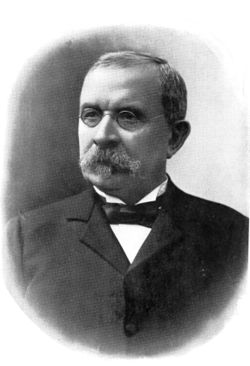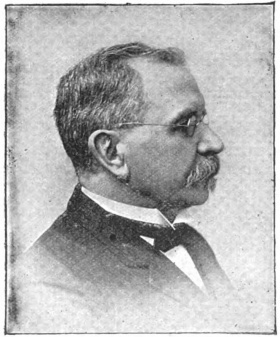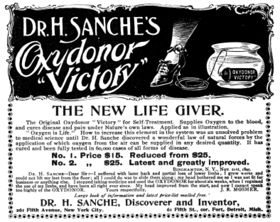Hercules Sanche
From Kook Science
| Hercules Sanche | |
|---|---|
 Publicity portrait of Dr. Hercules Sanche | |
| Born | 25 May 1838 Ste-Thérèse, Québec, Canada East |
| Died | 20 December 1928 (90) Montreal, Québec, Canada |
| Nationality | Canadian |
| Alma mater | L'École de Medicine de Quebec |
| Affiliations | Electrolibration Co.; Animarium Co.; Dr. H. Sanche Co. |
| Known for | "Diaduction"; Electropoise and Oxydonor gas-pipes |
| Spouse(s) | Corinne M. [Utter] (m. 1890) |
Hercules Sanche (May 25, 1838 - December 20, 1928) was a French Canadian inventor and entrepreneur, and self-proclaimed "Discoverer of the Laws of Physiological Combustion" and "Discoverer of the Laws of Spontaneous Cure of Disease," noted generally for his successful Electropoise and Oxydonor "Victory" gas-pipe nostrums.
Selected Bibliography
- Sanche, Hercules (1892), Spontaneous Cure of Disease Through the Use of Pocket Electropoise 'Victory'
- Sanche, Hercules (1895), Law of Physiological Combustion Upon which Organic Health Vigor, and Rapid Reanimation of Debilitate and Diseased Organism depend, and Diaductive Cure of Disease... Direction: How to Effect a Diaductive Cure of Disease through the use of Oxydonor 'Victory'
- Sanche, Hercules (1897), Diaductive Cure, Dr. H. Sanche Co., https://catalog.hathitrust.org/Record/100128860
- Sanche, Hercules (1902), How Man Lives And Is Master of Disease, Detroit, Mich.: Dr. H. Sanche & Co., https://catalog.hathitrust.org/Record/012348073
Selected Patents
- US 588483, Sanche, Hercules, "Apparatus for Treatment of Diseases", published 1897-08-17 — "It is unnecessary to state the theory of action of this apparatus[...] The mild and gradual action of the instrument, extending over a period of some hours, will produce effects of marked character and benefit. "
- GB 189716774, Sanche, Hercules, "Thermo-Electric Batteries", published 1898-08-15 — "The inventor has discovered that if a living organism be connected with another body in a different thermal or electrical condition by a moderate electrical conductor, rapid oxygenation or hydrogenation of the capillary blood is produced, and he utilizes this principle for invigorating the organism and for preventing or curing disease in the same."
- CA 62153, Sanche, Hercules, "Apparatus for Utilizing Natural Energy", published 1898-12-27 — "Placing a living organism in the attitude of a galvanic arrangement and in electrical relation to the - of the plates of a galvanic pair together with any source of the lower or higher temperature or with any substance in an electrical state corresponding to the same by being its electro-negative or electro-positive through an electrical connection of the two without circuit by a moderate electrical conductor or inductor for the purpose of invigorating living organism or of preventing or curing disease in the same as described and set forth."
Reading
- "An Electro-Medical Fraud; ELECTROPOISE, GROSSEST OF THERAPEUTIC HUMBUGS; The Electro-Libration Company and Its Abetters". Electricity: a Popular Electrical Journal 7 (19): p. 220-222. 1894-11-21. https://babel.hathitrust.org/cgi/pt?id=nyp.33433108212758;view=1up;seq=240.
- Cramp, Arthur J. (March 1911). "Gas-Pipe Therapy: The Modern Substitute for the Rabbit's Foot and Other Amulets and Charms - No. I". Life and Health: the National Health Magazine 26: p. 161-164.
- Wiley, Harvey W. (February 1914). "The Apotheosis of the Inert: An Interesting Tale of Fakes and Fakery in Revealing the Magic Virtues of the Oxydonor". Good Housekeeping Magazine 58: p. 247-253.
Advertising

